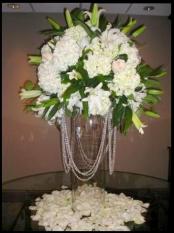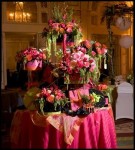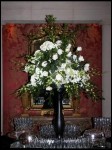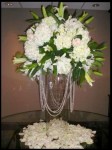History of Victorian Floral Design
The Victorian era was when arranging flowers was first recognized as an art form.
The Victorian era in American history marked a period of floral design we often see in elaborate, full designs. The Victorian era is named for Queen Victoria who rules England from 1837 to 1901. During this era, enthusiasm abounded for gardening, flowers and plants. The people were more strict, formal and prudish though decorations (including floral designs) were opulent, lavish and showy.
Upper-class members of society showed their wealth with large, excessive, opulent and often overdone flower arrangements created weekly by cultured ladies in the home and their daughters. This was also the time when tussie-mussie bouquets and nosegay bouquets made their mark in society. Lovers would exchange them as signs of affection. Proper women of Victorian society carried these bouquets at most social gatherings.
Elements & Principles of Victorian Floral Design
Style: Lavish, Full, Massive, Full of Seasonal Flowers, Opulent
Flowers Used: Primarily only MASS, FORM, and FILLER flowers are used. Fruits may also be incorporated with the flowers.
Seasonal flowers are appropriate for Victorian flower designs because during the era arrangements were typically made from flowers cut from the garden.
Roses are almost always required for a Victorian flower arrangement as they were very popular during the era. Other appropriate flowers are tulips, carnations, daisies, China asters, lilies, cockscomb, peonies, bleeding hearts, freesias, dahlias and baby’s breath.
Basic Design Characteristics of Victorian Style
Keep in mind that this style of flowers is very full and focuses on the opulence associated with an abundance of fresh flowers.Tightly massed flowers are characteristic of the style and time period.
Victorian style arrangements are typically round or oval in form. Flowers are typically kept to a lower height, only one to one-and-a-half times the container’s height.
Strong color contrasts and flowers with brilliant hues are preferred. Usually a full range of colors is used. However, monochromatic and analogous tones may also be used.
Lots of foliage is associated with Victorian style flower arrangements. They are used to soften the appearance of tightly massed flowers. Ferns and ivies are popular inclusions.
Containers Used in Victorian Flower Arrangements
Containers used in Victorian style flower arrangements are typically ornate and decorative. They should be showy but not outshine the flowers. A wide variety of containers can be used, ranging from China vases to baskets, urns, round bowls and other containers. Materials also vary. Two and three-tiered epergnes and stands are appropriate for this style.
If you have any comments or pictures of a Victorian style flower arrangement, please add them in the comments below.
- Table of Victorian Style Arrangements
- Tall Victorian Flower Arrangement
- Victorian Style Flower Arrangement


 Find Your
Find Your 





Awesome post! I’m a BIG fan of the victorian styles of floral design. I really enjoyed the tall victorian flower arrangement picture too – just elegant. These are the kinds of designs that anyone can create when selecting among the various florist careers. Thanks for sharing.
I really love the Victorian floral designs. I only see them in 5 star hotels now. I would have enjoyed living back in those days. Your page brings out the beauty in of these great flower arrangements. Thank for the information.
I will be doing two victorian arrangements for a centennial celebration in a private club in Boston. One will be compliment an \’outrageously beautiful\’ hat of scarlet, almost vermillion, velvet and feathers. The other will need to be more pastel and lacy. Any suggestions for plant material would be most welcome.
There are many, many options for Victorian style arrangements. Here is a list of lots of plant materials used in that era:
Flowers:
Double Anemone
Carnations
Crown imperial
Cyclamen
Foxglove
Hellebore
Day lily
Hollyhock
Hyacinth
Iris
Larkspur
Lilac +
Lily
Lupine
Narcissus
Nasturtium
Double Peony / Peony
Pinks
Poppy
Rose +
Tulips
Amaryllis
Aster
Balloon Flower
Jasmine
Lily-of-the-Valley
Marigold
Pansy
Primrose
Catkin
Clover
Daphne
Geraniums
Hibiscus
Phlox
Plum and Pomegranate blossoms
Snowdrop
Sorrel
Trumpet vine
Veronica
Foliage:
Hosta
Canna
Coleus
Ferns
Early Victorian designs favored dark, rich colors with golds. After the French Rococo movement, they transcended to lighter colors with silvers, and there was more of an emphasis on texture.
Accessory ideas:
Lace fans
Porcelain figures
Pillows
Leather-bound books
Sheet music
Hi I wonder if you could help me please with ideas concerning appropriate flowers, foliage to be used to create a flower arrangement suitable for a Victorian kitchen?
Kind regards Alexis
I would suggest a beautiful short urn-type vase, either something porcelain, ceramic or silver. As for flowers, right now I’d suggest lush hydrangea, roses and a small filler flowers in colors that match or complement your kitchen. Use cascading amaranth or something similar to give it a true, Victorian feel. You might add accents of feathers or strings of pearls for extra opulence. Hope this helps. When you choose your look, share a photo with us! I’d love to see what you create!
I was delighted to find this site because I am often asked to design work for placement in one of our VIctorian era Historic homes and it is good to see others are interested in this too.
If any of you are online right i would like to know what flowers where the most commonly used, so like the ones you would have seen the most.
Harlei,
Could you explain your question a bit more? Do you mean as a florist overall? In certain floral situations?